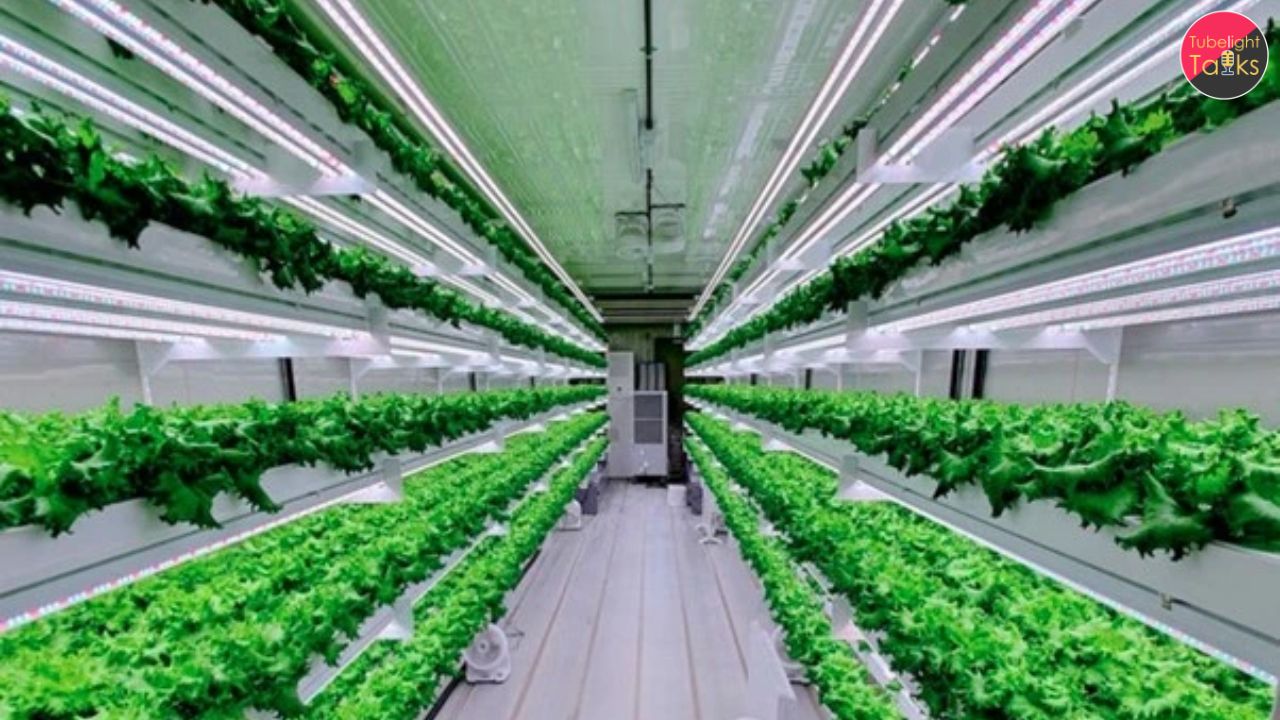Unlike conventional farming methods, Aeroponics enables plant growth in the absence of soil and even water based growing media. Instead, a fine mist of nutrient solution is delivered directly to the roots. As we know, today’s increasing population is creating pressure on traditional agriculture. Amidst this challenge, aeroponics is becoming a revolutionary solution in the field of high-tech, sustainable farming. It drastically reduces water consumption and maximizes space utilization. That’s why it is said that aeroponics is a vital technology in feeding the future.
What is Aeroponics?
The word “Aeroponics” is derived from two Greek words, “aer “( air) and “ponos” (labour). So, aeroponics is a method of growing plants in the air or mist environment without using soil or an aggregate medium. The roots of the plants are hanging in air and a mist containing essential nutrients and mineral water is spraying regularly on those hanging roots. In this technique, roots are open so plants can absorb more oxygen, significantly accelerating plant growth and improving its yield.
History and Evolution of Aeroponics:
The first concept of Aeroponics arose in the 1940s but remained largely experimental for decades. In the 1980s, NASA explored the use of this technique for space missions. At that time, scientists realized that aeroponics technology could provide a sustainable method for growing food in zero gravity environments. Since then, this technology has been adopted for terrestrial use, especially in water scarcity zones of urban areas and countries with limited arable land.
How Does Aeroponics Work?
An Aeroponics System consists of a few essential components:
- Growth Chamber: An enclosed or semi enclosed space where plants are held with their roots suspended in air.
- Misting System: Timed nozzles that spray a nutrient rich solution onto the roots.
- Reservoir and Pump: To store and circulate the nutrient solution.
- Sensors and Automation Controls: For monitoring humidity, temperature, pH and nutrient levels.
Aeroponics ensures that roots get direct exposure to oxygen and nutrients by delivering nutrients in mist form. This results in faster growth, better absorption and minimum resource waste.
Types of Aeroponics Systems:
1. Low pressure Aeroponics (LPA): This system is more affordable and simple. Also it is suitable for home and small scale systems.
2. High Pressure Aeroponics (HPA): This system uses high pressure pumps and mist nozzles. It is ideal for commercial setups.
3. Ultrasonic Foggers: This system uses sound vibrations to create nutrient fog. It is newer and still experimental.
Advantages of Aeroponics:
1. Less Water Usage: It uses up to 95% less water than soil based farming.
2. Faster Growth: Plants grow 2-3 times faster than soil based farming. It is due to enhanced supply of oxygen.
3. Disease Control: As no soil is used, there is less possibility of pests and soil borne diseases.
4. Space Efficient: Aeroponics System requires less space. Vertical aeroponic farms can also be built in urban buildings.
5. Nutrient Control: In Aeroponics Systems, precise control over nutrients is possible that leads to better yields.
6. Reusability: Closed loop system used in Aeroponics is reusable. So, minimum waste is produced.
Disadvantages and Challenges:
1. High Initial Cost: Equipment and automation systems are expensive.
2. Power Dependency: Aeroponics System is highly electricity and sensors dependent.
3. Lack of required knowledge: Aeroponics required technical knowledge. Also it needs skilled maintenance and monitoring.
4. Chances of System failure: If misting is stopped, roots dry out quickly.
Aeroponics vs Other Farming Methods:
1. Soil use:
– Aeroponics: No
– Hydroponics: No
– Traditional farming: Yes
2. Water usage:
– Aeroponics: Very low
– Hydroponics: Medium
– Traditional farming: High
3. Growth speed:
– Aeroponics: Fastest
– Hydroponics: Faster
– Traditional farming: Normal
4. Space usage:
– Aeroponics: Minimum
– Hydroponics: Moderate
– Traditional farming: Large
5. Disease Risk:
– Aeroponics: Low
– Hydroponics: Medium
– Traditional farming: High
6. Cost:
– Aeroponics: High
– Hydroponics: Medium
– Traditional farming: Low
Global Use Cases and Success Stories:
1. United States:
– Vertical farms like AeroFarms ( New Jersey) are pioneers.
– Using Aeroponics, leafy greens are grown in indoor vertical systems.
– These farms produce crops year round with 95% less water.
2. Singapore:
– Singapore has embraced aeroponics on rooftops and indoor farming with limited land.
– Through government supported projects like Citiponics, Singapore is increasing its food self sufficiency.
3. UAE and Middle East:
– Aeroponics helps in water conservation, mostly in desert regions where arable land is scarce.
– Local food production is done.
– Aeroponics reduces its dependency on imports.
4. India:
– Startups like UrbanKissan, Agro2o and BitMantis Innovations are experimenting with aeroponics in urban areas.
– Using smart systems like aeroponics, fresh vegetables are grown locally.
India’s Growing Aeroponics Industry:
With its vast population, India stands to benefit significantly from aeroponics. Some key developments include:
1. CSIR and IARI Initiatives: Research institutes are developing low cost aeroponic models for farmers.
2. State Agriculture Departments: In metro cities, these departments are supporting urban aeroponic farms.
3. Startup Ecosystem: Mumbai, Pune, Bengaluru and Delhi are witnessing a rise in aeroponic based urban farming ventures.
Application in Different Crops:
– Aeroponics is especially effective for following crops:
1. Leafy Greens: Lettuce, Spinach, Kale
2. Herbs: Basil, Oregano, Thyme, Mint
3. Strawberries
4. Cherry Tomatoes
5. Potatoes ( Aeroponic Seed Potato Systems)
– Advanced Aeroponics is also being tested for rice seedlings and medicinal plants.
Aeroponics in Urban Farming and Vertical Agriculture:
– Due to increasing demand for fresh, local produce, Urban Farming is gaining momentum. Aeroponics plays a crucial role by allowing:
1. Year Round production
2. Farming in basement, rooftops and containers
3. Elimination of Transport costs and carbon footprint
4. Employment generation in urban agritech sectors
Economic and Environmental Impact:
1. Water conservation: Water savings are significant in drought prone areas.
2. Land Use Optimization: Reduce need for deforestation or land conversion.
3. Reduced Use of Chemicals: Less use of pesticides and fertilizers.
4. Job Creation: Opens new roles in smart farming, maintenance and supply chain.
Aeroponics and Food Security:
– With the global population projected to cross 9 billion by 2050, traditional farming may not suffice.
– Aeroponics provides:
1. Local Food Production
2. Climate Resilient Systems
3. Shorter food supply Chains
4. Consistent, high quality produce
Technological Integration in Aeroponics:
– Modern aeroponics integrates:
1. IoT Sensors for nutrient and environment monitoring
2. AI Algorithms for optimizing misting cycles
3. Mobile Apps for indoor photosynthesis
Government Policies and Support:
1. PM-KUSUM Scheme ( for solar- powered systems)
2. Startup India and Agritech Innovation Programs
3. Subsidies for vertical farming
– However, the adoption of aeroponics in rural India is still at an early stage and requires policy push.
Future of Aeroponics in India and Globally:
– Global Market Projection: Expected to reach $3 billion+ by 2028.
– Integration with AI, Blockchain and robotics.
– Rising demand for clean, pesticide free food.
– Scope in high-end restaurants and organic markets.
Spiritual Call to Humanity: The Real Solution to Global Hunger
While scientific innovations like aeroponics offer temporary relief from food crises, the permanent solution lies in spiritual transformation. As revealed in the Bhagavad Gita Chapter 15, Verse 17, there exists a Supreme Immortal God, the Uttam Purush ( Supreme Being), who nourishes all living beings across the three worlds.
Sant Rampal ji maharaj ji has revealed through Satgyan from all holy scriptures that this Supreme God is none other than Kabir Saheb Ji, who is present today on earth in the form of Sant Rampal ji maharaj himself. He has the divine capability to feed and protect every soul from elephant to ant, and from the poorest to the richest. Because all living beings are His children. To fulfill this divine mission, Sant Rampal ji maharaj has launched the Annapurna Mohim, ensuring that no human sleeps without food.
We humbly request the entire world to take Naam Initiation ( Diksha) from Sant Rampal ji Maharaj and surrender at His feet. If the world embraces His grace and teachings, He will not only solve the future food scarcity problem but also every pain and suffering of humanity, physical, social and spiritual. The Supreme Power has descended; the solution is not far, it is here, in the form of true devotion and surrender.
Conclusion
Aeroponics, though in its nascent stage in many parts of the world, represents a paradigm shift in how we produce food. By eliminating the need for soil and significantly cutting water use, it addresses some of the biggest agricultural challenges today. With the right investments, policy support and public awareness, aeroponics can play a vital role in ensuring food for future generations, all while caring for the planet.
FAQS:
Q1. What is Aeroponics?
A. Aeroponics is a soil-less farming technique where plants are grown in air or mist environment without use of soil or any other medium. The roots are suspended in air and are regularly sprayed with nutrient rich water.
Q2. How is aeroponics different from hydroponics?
A. In Hydroponics, plant are grown in nutrient rich solution or an inert medium like cocopeat or perlite. In Aeroponics, the plant roots are exposed to air and misted with nutrients. Aeroponics uses less water and allows more oxygen to reach the roots.
Q3. Is aeroponics suitable for all types of crops?
A. Aeroponics is best suited for fast growing, lightweight crops like leafy greens ( lettuce, spinach), herbs ( basil, mint), and some vegetables ( tomatoes, strawberries). Heavy root crops like potatoes are less suitable.
Q4. What are the main advantages of aeroponics?
A.
– Uses up to 90% less water than traditional farming
– Faster plant growth due to increased oxygen
– No risk of soil borne diseases
– Space Efficient, ideal for Vertical farming and urban agriculture
– Year round production
Q5. What are the disadvantages or challenges of aeroponics?
A.
– High Initial setup cost
– Requires uninterrupted power supply
– Skilled labor and technical knowledge needed
– Vulnerable to system failures ( e.g., pump malfunction can dry out roots quickly)
Q6. Can Aeroponics be used at home?
A. Yes, Aeroponics kits are available for home gardening. However, they require careful and regular monitoring and maintenance, so some experience in gardening is helpful.
Q7. Is aeroponics organic?
A. Aeroponics can be organic if the nutrients used are derived from natural, organic sources. However, many systems use synthetic nutrients, which may not qualify as organic under certification rules.
Q8. How much does it cost to start an Aeroponics farm?
A. The cost can vary widely based on scale. A small home setup may cost ₹10,000 to ₹50,000, while a commercial unit can cost ₹5 lakh to ₹50 lakh or more, depending on automation and size.










